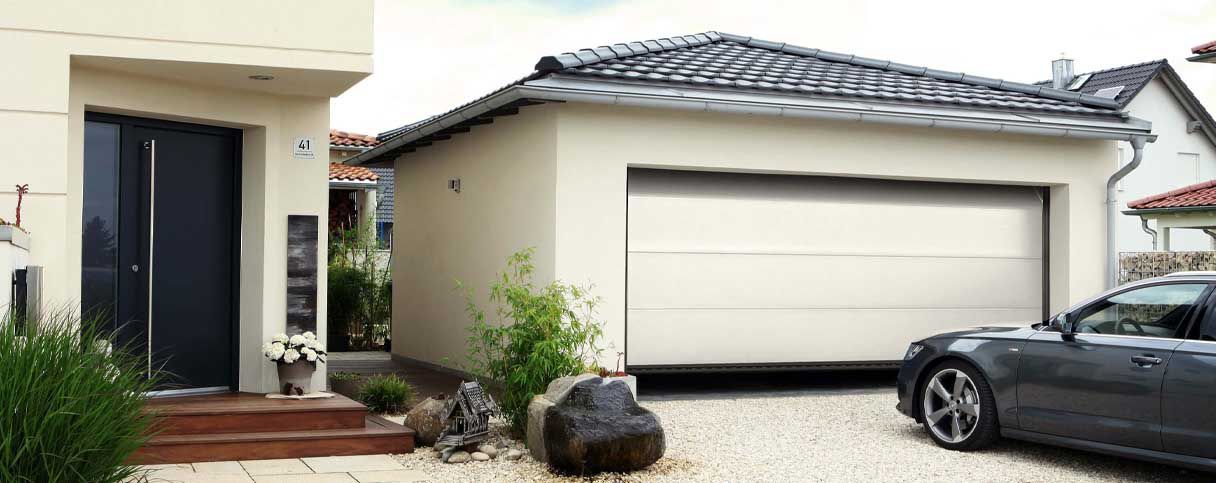
Brick-built vs. prefabricated garage
Brick-built vs. prefabricated garage: Advantages and disadvantages
Hail, frost, snow, even the sun and its UV rays – all these weather caprices can affect cars. As a consequence, the bodywork is impaired and the vehicle’s value drops. That’s why a garage is a must for many people. The unwritten law is: If you have the space, you build a garage. Or at least a carport. Garages can also be used for storage, for overwintering sensitive plants, or even for a bar. But before they can think about how they’re going to use their garage, owners first have to make a basic decision: a prefabricated or brick-built garage? Our blog post sets out the advantages and disadvantages of both options.
Brick-built garages: Advantages and disadvantages
In our part of the world, a brick-built garage is still the classic choice that will likely never go out of fashion. It’s no wonder, because this construction method offers garage owners an array of advantages – first and foremost the huge scope of design freedom. If you choose this option, you can have a garage built entirely to your own taste. Whether a double garage with lots of storage space, or a garage with a roof on which a photovoltaic plant can be installed – it can all be tailored closely to your preferences. And the traditional brick structure can be matched to the architecture of your house. Another advantage is that brick-built garages provide outstanding thermal insulation, and can be additionally used as a workshop or tool shed, for example, provided the appropriate planning consent is obtained where necessary. The disadvantage: Brick garages are usually more expensive, and take longer to build. One reason is the solid foundation that has to be laid as the starting point. Their construction work also requires the use of equipment, in particular a concrete mixer.
Prefabricated garages: Advantages and disadvantages
Prospective garage owners also have the option of choosing a prefabricated garage. The big advantage of this alternative is the time factor. Prefabricated garages are usually delivered as a finished product, or the individual components merely have to be joined together, which can be done just as quickly. Moreover, prefabricated garages are generally cheaper to buy than brick-built variants. Some concessions often have to be made with regard to insulation, however, and since prefabricated garages by definition are largely pre-determined in design, there is little choice in terms of styling. Concrete, steel or sheet metal prefabricated garages are the most popular.
Concrete garages: These prefabricated garages come closest to brick-built garages in terms of robustness and individuality, but they are much easier to build, so they can be erected in just a few hours. The disadvantage: Concrete does not have good insulating properties, which limits the possibilities for using the garage, and means that greater care needs to be taken to ensure proper ventilation. Also, concrete garages are extremely heavy, which must be considered both in terms of the garage’s placement and when transporting the heavy load for delivery.
Steel garages: Steel garages offer a further option. These can nowadays be customised, at least to some extent, by way of different roof shapes, paint finishes and styling features. Ease of assembly – potentially by someone with reasonable DIY skills – further reduces the cost of this already quite inexpensive alternative. Other advantages are durability lasting at least 15 years, good ventilation, and the option to rapidly swap out broken components. The disadvantage: Garage owners have to make concessions in terms of sound and heat insulation. Additional insulation is therefore often required.
Sheet metal garages: Sheet metal garages are quick to assemble and inexpensive. They can likewise be visually enhanced by exterior rendering or painting, and will last on average 10 to 15 years. Other advantages are good ventilation and high resistance to rust. However, sheet metal garages cannot be placed on uneven base surfaces, and the possible uses of this variant are also limited, as they would additionally require insulation in order to regulate the temperature inside or to supply the garage with power.
The right garage door for the perfect garage
A prefabricated or brick-built garage – like so many things, the choice will depend on your own preferences, your property, your available budget, and the time available. No matter which garage variant you choose, it is important to find the right door for it. Many Normstahl garage doors feature ball-bearing rollers and tandem running gears, a floor seal with optional integrated ventilation system and tested burglar-proof protection. Other features, such as a finger trap guard, opening block, spring break protection and obstacle detection, enhance safety in day-to-day use. And we provide a ten-year manufacturer’s warranty on garage doors, including wearing parts. Need help choosing? We’re there for you. Just contact your local Normstahl dealer.